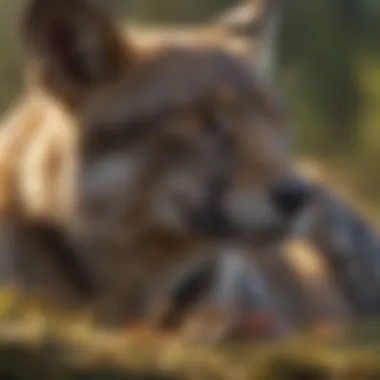Strategies for Wildlife Management in the South


Intro
Wildlife management in the southern corners of the United States is as diverse as the wildlife itself. It does not simply revolve around animal preservation; it’s a delicate balancing act involving ecological factors, legal guidelines, and community interests. Each element plays a critical role in shaping strategies that define how we approach wildlife conservation. Understanding these layers can help homeowners and housewives craft their own approaches to dealing with various pests.
Preventive Pest Control Strategies
Taking steps to curb pest issues before they escalate is a sound approach, especially in warmer climates where pests can proliferate with alarming speed. Here’s a back-to-basics guide emphasizing preventive measures everyone can adopt.
House Exterior Protection
Tips for sealing cracks
Cracks and crevices often serve as gateways for pests. Fill gaps around windows and doors with caulk or foam sealants. Regular inspections can help you spot weak spots before they become problematic.
Clearing debris
Overgrown vegetation and piled leaves can attract unwanted visitors. Keep your yard tidy by regularly raking leaves and trimming shrubs. A clear perimeter makes a significant impact in keeping pests at bay.
Preventing pests from entering
Consider installing screens on open windows and vents. This simple barrier can block many flying nuisances from making their way indoors.
Yard Maintenance
Essential yard care routines
Regular mowing and watering routines not only keep your yard looking fresh but also reduce pest breeding grounds. Set a schedule, so you remain consistent in maintaining your yard.
Methods for keeping yard pest-free
Certain plants can repel pests naturally. Incorporating herbs like basil or lavender not only brightens up your garden but also acts as a natural deterrent for many troublesome insects.
Indoor Cleanliness
Expert cleaning tips and techniques
A clean kitchen is a big deterrent for pests like ants or cockroaches. Wipe down surfaces regularly and avoid leaving food out.
Maintaining a pest-resistant indoor environment
Storing dry foods in airtight containers can create a significant barrier against insects. Don't also forget to keep an eye on pantry items; those pesky moths might be hiding in plain sight.
Garbage Disposal
Efficient waste disposal methods
Utilizing garbage bins with tight-fitting lids is a simple yet effective measure. Always ensure bins are emptied regularly.
Importance of proper garbage disposal
Organic waste should not linger. Zero tolerance for food scraps lying around helps minimize attraction for pests.
Other Pest Prevention Strategies
Innovative ways to safeguard your home
Consider installing a fence or barrier around your garden or yard. This can add another layer of defense against larger wildlife that may rummage through your property.
Identifying Pest Risk Areas
Identifying and monitoring areas that could breed pests is key.
Moisture Prone Areas Inspection
Identifying damp conditions
Check under sinks, around baths, and any places moisture might build-up. Keep these areas dry to prevent inviting pests that thrive on wetness.
Tips for preventing infestations
Using a dehumidifier can help control moisture levels, making your home less inviting for pests.
Crack and Crevice Inspection Guide
Importance of inspecting access points
Regularly inspect your home for any tiny access points pests could use to enter. Remember, if you can see a light through a crack, it might be an invitation for pests!
Strategies for sealing cracks and crevices
Using caulking and weather stripping is an effective way to seal potential entry points.
Greenery Inspection for Pest Risks
Understanding greenery's impact on pests
Plants, especially overgrown ones, can mask nests and breeding grounds of unwanted pests.
Guidelines to maintain pest-free yards
Regularly trimming and keeping plants a safe distance from your home can make a real difference.
Additional Pest Risk Areas
When assessing risk areas, don’t forget to consider other potential vulnerabilities, such as attics, basements, and garages. These often neglected areas can offer harbors for pests.
Effective Pest Control Methods
Natural Repellents for Pest Control
Safe and effective natural solutions
Consider eucalyptus oil or citronella as a natural pest deterrent. Not only are they safe around children and pets, but they are also effective in keeping bugs at bay.
Use of essential oils, herbs, and plants
Utilizing a blend of these can offer a dual-purpose, providing beautiful scents along with pest control.
Chemical Sprays for Pest Control


Safe usage of professional sprays
If opting for chemical solutions, always follow label instructions carefully and ensure proper ventilation. Misuse can lead to more problems than solutions.
Eradicating pests with chemical solutions
Take the time to identify the kinds of pests you’re dealing with, as different sprays target different infestations.
Pest Traps: Effective Pest Control Solutions
Setting up and using pest traps
From sticky traps for insects to snap traps for rodents, setting them strategically can maximize their effectiveness.
Capturing and removing pests safely
Make sure to check traps regularly and dispose of captured pests humanely.
Biological Control Methods for Pest Prevention
Using natural predators for pest management
Incorporating natural predators into your environment can reduce pest populations without harmful chemicals.
Environmental-friendly pest control techniques
Planting flowers that attract beneficial insects can offer a hands-off way of keeping pests in check.
Other Pest Control Methods
Innovative pest control methods beyond traditional options
Consider using ultrasonic repellents for a more tech-savvy approach to pest control. These devices emit sounds that deter pests without harming them.
Pest Species Identification
Common Insects in Home Pest Control
Recognizing and managing insect infestations
Being familiar with the most common pests like bees, ants, and roaches can be invaluable for early detection.
Identifying Rodents for Pest Prevention
Tips for identifying and preventing rodent invasions
Look for droppings or gnaw marks, and keep food sealed tightly to deter these nuisances.
Bird Species Impacting Home Environments
Addressing bird-related issues around the home
Pigeons and starlings can create messes and introduce pests; certain netting can help keep them away.
Dealing with Wildlife on Your Property
Handling wildlife encounters effectively
It’s important to learn how to respect wildlife while also keeping your property safe. If confronted with larger wildlife, maintaining a safe distance is key.
Miscellaneous Pest Species Identification
Knowledge is power when it comes to identifying both common and lesser-known pests. Be observant, and act quickly if something looks out of place.
DIY Pest Control Techniques
Homemade Pest Control Solutions
Eco-friendly homemade pest control remedies
A mix of soap and water can in many cases act as an effective spray against soft-bodied insects.
Using Essential Oils for Pest Control
Repelling pests naturally with essential oils
You can create your own blend of oils like peppermint or tea tree, which can be sprayed around the home.
Effective Pest Traps and Barriers
Setting up traps and barriers for pest control
Utilize household items to create effective barriers, like placing diatomaceous earth around plants to deter slugs.
Top Reputable Pest Control Brands
Products for home pest management from trusted brands
Research recommend all the safety and efficacy of products from brands like Ortho and Raid to keep your home pest-free.
Miscellaneous DIY Pest Control Techniques
Experimenting with different home remedies can lead you to discover effective methods for controlling pests without breaking the bank.
Overview of Southern Wildlife Management
Wildlife management in the southern regions of the United States holds considerable significance, touching upon various layers of ecological complexity and community interaction. This overview aims to map out the landscape of challenges and opportunities embedded within the practices that safeguard southern wildlife. The need for effective management strategies is paramount, as they not only ensure the protection of diverse species but also play a crucial role in preserving the intricate ecosystems that sustain them.
Definition and Scope
At its core, wildlife management refers to the art and science of balancing the needs of both humans and wildlife. This balance is necessary to foster healthy wildlife populations while also considering human activities that encroach upon their habitats. The scope of this management in the south is extensive; it includes everything from regulating hunting to advocating for habitat conservation. It also encompasses education initiatives aimed at promoting harmonious coexistence between communities and wildlife. Various stakeholders, including state and federal agencies, conservation groups, and local residents, play a role in this broad landscape.
The southern United States is incredibly biodiverse, housing a wide array of species native to the region. Understanding how to manage these species is crucial to the ecological integrity of the area. However, defining a clear scope for management practices can be challenging, given the various interests and motivations that influence these activities.
When it comes to wildlife management strategies, key terms to consider include:
- Sustainable practices: These are vital for ensuring that wildlife populations can thrive alongside human development.
- Ecosystem services: Recognizing the benefits that ecosystems provide allows for more effective management frameworks.
- Community engagement: Involving local populations in conservation efforts leads to more successful outcomes.
Historical Context
To truly grasp the nuances of southern wildlife management today, one must dive into its historical context. The transformation of wildlife management in the south reflects a shift from exploitative practices to more ecologically sound approaches. In the early years, prioritization hinged on hunting and agricultural expansion, often disregarding the environmental consequences. Animals such as the passenger pigeon and the eastern bison faced severe declines due to overhunting and habitat destruction.


As awareness of ecological principles grew, so did the realization that wildlife conservation necessitated a partnership between nature and humans. The establishment of the National Park Service and various state parks marked a pivotal turn in policy and attitudes towards wildlife. These changes laid the groundwork for a more structured approach to wildlife management that incorporates science and community input. The historical evolution showcases:
- The transition from over-exploitation to preservation.
- The growing recognition of biodiversity’s value in maintaining the health of ecosystems.
- Efforts made to restore degraded habitats, highlighting a commitment to integrating restoration practices into management strategies.
In summary, the tale of southern wildlife management intertwines ecological awareness with historical progress. Understanding this trajectory helps in developing strategies that not only protect wildlife but also engage communities in a meaningful way. The dialogue surrounding wildlife management can now create more harmonious relationships between people and the environment, securing a more sustainable future.
Ecological Balance in Southern Habitats
Ecological balance refers to the stabilizing interactions between various species and their environment. It's particularly significant in southern habitats, where the interplay between human activities and wildlife is dynamic and often complicated. This delicate equilibrium is crucial not just for species survival but for the health of entire ecosystems. Maintaining this balance can yield numerous benefits, including improved biodiversity, resilience against invasive species, and overall ecosystem productivity. Understanding these elements is paramount to formulating effective wildlife management strategies.
Biodiversity and Ecosystem Health
Biodiversity ties directly to ecosystem health. The southern regions of the United States, with their unique climatic and geographical characteristics, boast a myriad of species—from alligators in swamps to diverse bird populations soaring across open skies. Each species has a role, contributing to the food chain and influencing habitat structure. Healthy ecosystems, filled to the brim with diverse species, ensure pollination, seed dispersal, and nutrient cycling.
In a more intricate sense, biodiversity acts almost like a safety net. For instance, when certain species falter due to environmental stressors or human interference, the presence of other species can often help maintain functional stability. As the age-old saying goes, 'don't put all your eggs in one basket.' The more diverse an ecosystem, the better chances it has to withstand shocks—like disease outbreaks or climate fluctuations.
"An ecosystem flourishing with life will find its own way to recover from disturbances, proving its inherent strength."
Threats to Habitat Integrity
Despite the intrinsic value of ecological balance, southern habitats face numerous threats that jeopardize their integrity. Urbanization is a major concern, as cities expand into natural areas, making way for homes and infrastructure. This encroachment can fragment habitats, isolating wildlife populations and making it harder for them to thrive. Additionally, pollution from industrial activities and agricultural runoff can degrade water sources, further stressing local wildlife.
Another considerable threat is climate change. Changes in temperature and weather patterns could lead to shifts in species distributions and the timing of biological events like migration and breeding. This disarray complicates the natural order that species have evolved over time to depend on. The ramifications are profound and extend far beyond mere survival—impacting food sources, mating rituals, and interactions within the ecosystem.
To summarize, maintaining ecological balance in southern habitats is not just about protecting a few select species. It's about ensuring the interconnected web of life remains robust and resilient against a variety of threats. Recognizing these elements underscores the importance of adopting strategic wildlife management practices that promote both biodiversity and habitat integrity.
Wildlife Populations and Species Management
Understanding wildlife populations and species management in the southern regions is crucial for maintaining the delicate ecological balance. Southern states boast a unique diversity of flora and fauna, shaped by varied ecosystems and climatic conditions. Therefore, ensuring that these wildlife populations thrive is not just about preserving a few charismatic species; it’s about safeguarding an intricate web of life which humans depend upon.
Effective management strategies contribute to the overall health of ecosystems, influencing everything from soil quality to the availability of clean water. When wildlife populations are well managed, we can mitigate problems like habitat degradation and species extinction, which can have cascading effects that impact other plants and animals. Moreover, responsible management encourages biodiversity, which is vital for resilience against diseases and environmental changes.
Key Species within the Region
In the Southern U.S., several species take center stage, acting as indicators of ecosystem health. Species like the Eastern Wild Turkey, Painted Bunting, and the Red-shouldered Hawk illustrate the rich biodiversity of this area. These animals not only captivate our attention, but they also play pivotal roles in their respective habitats.
- Eastern Wild Turkey
A prized game bird, the Eastern Wild Turkey is significant for both its ecological role and economic value through hunting. Their presence indicates a healthy habitat that can support a variety of wildlife. - Painted Bunting
This colorful songbird is a delight for birdwatchers and serves as a crucial pollinator, contributing to the health of various flowering plants within its range. - Red-shouldered Hawk
As a top predator, the Red-shouldered Hawk helps regulate populations of smaller birds and rodents, keeping the ecosystem balanced.
"The presence of key species not only enriches the environment but also provides invaluable services that contribute to ecological stability."
Management practices should prioritize these key species, as their health often reflects the state of wider ecological conditions. Supporting their populations can lead to a renaissance of biodiversity, strengthening habitats across the southern landscape.
Population Dynamics and Monitoring
Monitoring wildlife populations and understanding their dynamics is paramount for successful management. Population dynamics refer to the ways populations change over time due to births, deaths, immigration, and emigration. Monitoring helps wildlife managers to gather data on how populations are responding to environmental changes, human activities, and management initiatives.
Effective monitoring strategies can include a mix of field surveys, camera traps, and tracking software. Wildlife managers might use these methods to evaluate:
- Reproductive rates: Keeping an eye on how many young each species is producing is essential to understanding population sustainability.
- Movement patterns: What routes do animals take during migration? How do they adapt to changes in habitat? Understanding their movement aids in managing corridors for safe passage.
- Population estimates: Knowing how many individuals are present in a given area can inform hunting regulations, habitat preservation efforts, and conservation strategies.
In essence, robust population monitoring ensures that the management approaches remain relevant and adaptive to changing conditions, considering not just short-term gains but also long-term ecological health. By maintaining a focus on wildlife populations and their intricacies, management efforts can enhance the sustainable future of southern habitats.
Conservation Policies and Regulations
In the arena of wildlife management, conservation policies and regulations stand as crucial frameworks that not only guide activities but also safeguard our natural heritage. Implementing effective conservation policies ensures that both wildlife and their habitats are preserved for future generations. This section discusses the intricate dynamics between state and federal laws, alongside the impacts these have on wildlife practices.
State and Federal Legislation
Understanding the landscape of state and federal legislation is essential for anyone involved in wildlife management. The legal architecture varies across the Southern region, with federal laws like the Endangered Species Act setting foundational guidelines that protect threatened and endangered species nationally. At the state level, laws can differ widely, influenced by local ecology, economic interests, and cultural values.
For instance, in states like Georgia, the Department of Natural Resources has enacted specific regulations concerning hunting seasons, game limits, and habitat protection initiatives. On the other hand, Texas has its own set of statutes that reflect its large agricultural sector, often integrating land-use policies to balance wildlife conservation with landowner rights.
Some of the key legislative measures include:
- The Migratory Bird Treaty Act, which protects migratory birds by regulating hunting and habitat destruction.
- The National Environmental Policy Act (NEPA), which mandates federal agencies to assess the environmental effects of their proposed actions before making decisions.
- State Wildlife Action Plans, where each state outlines a strategy to conserve wildlife and habitats.
These laws create a complex web of regulations that wildlife managers must navigate. A solid grasp of this legislation helps in crafting strategies that comply with the law while effectively protecting wildlife.
Impact of Policy on Wildlife Practices
The impact of policy on wildlife practices is profound, dictating how conservation efforts are implemented, what practices are endorsed, and, in many cases, which species thrive or decline. Compliance with legislation influences decisions made by landowners, conservationists, and governmental bodies alike.
Policies shape not merely the safeguard of species but also define the interactions humans have with nature.
For example, strict regulations on hunting endangered species can lead to increased monitoring and management of local populations. Conversely, when policies are less stringent, overhunting may threaten vulnerable wildlife. This duality illustrates how policy not only serves as a protective measure but also directly affects the populations it aims to nurture.
Also, community involvement is intertwined with policy implications. As regulations encourage or mandate wildlife conservation education, local communities become more informed. This understanding fosters a collective responsibility toward preserving nature. It opens doors for collaboration between governmental organizations and civilian efforts, which ultimately strengthens conservation outcomes.
Policies that support ecotourism as an economic incentive further reflect a conscious shift toward sustainable practices. When wildlife conservation intertwines with local economic growth, it presents opportunities for communities to engage in practices that benefit both their livelihoods and the environment.
Navigating these intricacies is fundamental for housewives and homeowners aiming to understand their roles in wildlife management and conservation efforts. Being aware of how conservation policies unfold can empower individuals to participate actively in local conservation strategies and advocate for balanced wildlife management.
Human-Wildlife Interactions
Understanding human-wildlife interactions is crucial in the context of wildlife management in southern regions. This area of study not only highlights the relationships between residents and their local wildlife but also underscores the importance of sustainable coexistence. With urbanization and habitat encroachment increasing, conflicts often arise, making effective management strategies key for both wildlife conservation and community well-being.
Conflict Resolution Strategies
Conflicts between humans and wildlife are, unfortunately, all too common. When bears rummage through garbage cans or deer nibble on prized gardens, frustrations can boil over. Therefore, developing effective conflict resolution strategies is essential. Education plays a pivotal role here. Many communities have adopted programs that teach residents proper waste management techniques, such as using bear-proof trash containers. Furthermore, understanding animal behavior can lead to better mitigation. For example, knowing that deer are less likely to enter yards with certain types of fencing can encourage homeowners to invest in these barriers.
Additionally, engaging local wildlife agencies in conflict resolution is vital. These organizations can provide resources and engage in on-the-ground efforts to discourage wildlife from entering populated areas. Strategies like creating buffer zones, installing wildlife crossings, and promoting habitat enhancement away from urban areas can help minimize these interactions.
"With informed communities and effective interventions, many wildlife conflicts can be resolved before they escalate."
Community Involvement and Education
At the heart of successful wildlife management lies community involvement and education. It’s not just the responsibility of conservationists or local governments; every homeowner and inhabitant plays a part. Organizing community workshops and events fosters a sense of belonging and raises awareness about local wildlife challenges and solutions. For instance, residents can participate in citizen science projects, where they help monitor local species and contribute valuable data to conservation efforts.
Moreover, educational campaigns that provide easy-to-understand information about local ecosystems help demystify wildlife behavior. Households can learn the dos and don'ts of living alongside nature, such as securing food sources and maintaining gardens in ways that deter unwanted animals.
The collaboration between community members can lead to innovative solutions suited to specific local contexts. Each neighborhood might face unique challenges, and pooling resources or ideas can lead to more targeted, effective approaches.
Technological Innovations in Wildlife Management
Technological innovations have become crucial in the field of wildlife management, especially in the Southern United States where diverse ecosystems are at play. These advancements not only enhance the effectiveness of managing wildlife populations but also contribute to understanding ecological dynamics more comprehensively. The integration of technology into management strategies leads to more informed decision-making and long-term ecological sustainability. From data collection to innovative monitoring techniques, the benefits of these advancements are manifold, making them indispensable tools in this field.
Remote Sensing and Data Analysis
Remote sensing technologies have transformed how wildlife managers gather and analyze data. By utilizing satellites or aerial imagery, it's possible to monitor large areas and detect changes in land use, habitat condition, and even wildlife movement patterns over time. This technology allows managers to observe trends that may not be apparent from ground-level surveys alone.
One significant advantage of remote sensing is the ability to collect data over vast expanses of land without disturbing the wildlife. Information such as vegetation health, changes in habitat structure, or even the presence of invasive species can be gathered efficiently. For instance, using satellite imagery, one can observe how development encroaches upon natural habitats, prompting timely action to mitigate potential harm.


Moreover, data analysis plays a vital role in interpreting the information gathered through remote sensing. Employing Geographic Information Systems (GIS) enables wildlife managers to visualize data, making it easier to identify patterns and develop informed conservation strategies.
Emerging Tools and Techniques
As the field of wildlife management evolves, so do the tools and techniques used to study and manage wildlife effectively. One area seeing significant growth is the implementation of drone technology. Drones provide an aerial perspective that was previously difficult to attain, making wildlife monitoring less intrusive and more efficient. They can easily navigate tough terrains while capturing high-resolution images that help assess animal populations or detect poaching activities.
Another promising development is the use of camera traps. These devices, often powered by motion sensors, allow for the monitoring of wildlife populations without direct human intervention. They provide valuable data on species presence, behavior patterns, and even population density over time. Additionally, the data collected can be analyzed using AI algorithms, which can identify species and count populations automatically, thus streamlining data analysis processes.
"Incorporating technology into wildlife management not only improves efficiency but also engages community stakeholders, fostering a shared commitment to conservation."
Furthermore, advancements in mobile applications provide indispensable platforms for reporting wildlife sightings or monitoring conditions in real time. Local communities can partake in wildlife management by contributing information, which acts as an informal but powerful data source.
In summary, integrating remote sensing technologies, drone usage, camera traps, and mobile applications highlights a paradigm shift in how wildlife management is approached. By adopting these innovations, the goal of achieving a harmonious balance between human needs and wildlife preservation becomes more attainable.
Economic Implications of Wildlife Management
Wildlife management in the southern regions encompasses far more than just preserving animal populations; it also plays a significant role in the economy. Understanding the economic implications is crucial, as the balance between wildlife conservation and financial viability can yield benefits that extend into numerous sectors. Proper management strategies can enhance local economies, promote ecotourism, and contribute to long-term sustainability while ensuring regulatory compliance.
Revenue from Ecotourism
Ecotourism has emerged as a powerful engine driving the economies of southern regions rich in biodiversity. Tourists flock to experience the natural beauty, unique species, and stunning landscapes that these areas provide. Some benefits of ecotourism include:
- Job Creation: The rise in ecotourism spurs job growth in fields including hospitality, guiding, and conservation efforts that require skilled labor.
- Economic Stimulation: Increased visitation leads to higher spending in local restaurants, shops, and accommodations, which weave a fabric of economic interdependence in communities.
- Funding for Conservation: Many ecotourism ventures contribute a portion of their revenues to local wildlife and habitat preservation projects, creating a sustainable loop of environmental stewardship and economic growth.
As an example, a recent initiative featuring guided wildlife tours in the Florida Everglades attracted significant tourist traffic, effectively doubling local revenue streams while promoting conservation awareness. The potential for further development is rich as communities realize their natural surroundings can be both cherished and lucrative.
Cost-Benefit Analysis of Management Practices
With wildlife management comes the responsibility of determining the most efficient practices regarding economic commitment. Conducting a cost-benefit analysis is vital for assessing how best to allocate limited resources without compromising conservation goals. Key elements to consider include:
- Financial Investment: To develop effective management practices, up-front investment is necessary. This can include funding for research, facilities, and personnel advancements. Understanding these expenses is pivotal for stakeholders.
- Outcomes and Benefits: Evaluating the long-term advantages of these invested resources becomes essential as well. These benefits might not be directly apparent and are often seen in improved wildlife populations, restored habitats, or increased community engagement.
- Social Considerations: The societal impact also factors into the equation. A well-managed wildlife program can improve community resilience and promote a shared sense of responsibility for local ecosystems.
Overall, a thorough cost-benefit analysis provides invaluable insights that inform decisions and policies surrounding wildlife management. It ensures that the approach taken aligns not only with conservation goals but also supports the economic well-being of the communities involved in these initiatives.
"Ecotourism and sound management practices not only benefit wildlife but can also uplift entire communities economically, fostering a harmonious relationship between humans and nature."
In wrapping up the discussion on the economic implications, it becomes clear that when conducted thoughtfully, wildlife management can serve as a catalyst for enhancing the social fabric of southern communities while ensuring valuable natural resources are preserved for generations to come. The interplay of conservation efforts and economic viability creates an environment where both nature and people can thrive.
Climate Change and Its Impact
Climate change is shaping up to be one of the most pressing challenges in wildlife management across the southern United States. With the region's unique ecosystems facing shifts in weather patterns, rising temperatures, and fluctuating water resources, the implications for wildlife are profound. This section delves into how these environmental changes require targeted strategies for adaptation, assessing not just immediate responses but also planning for the long haul.
Adapting to Changing Conditions
As the climate continues to evolve, wildlife managers are confronted with the task of adapting practices to ensure the health of various species and their habitats. This isn't just about reacting to changes, but proactively implementing methods that are informed by scientific research.
For example, one significant change is the increased frequency of extreme weather events, including heavy rainfall and drought. Wildlife management efforts must now incorporate contingency plans that can adjust quickly to these shifts. A practical approach can be to develop several water management strategies that can be activated based on current conditions. These might include creating artificial ponds to serve as drought relief or enhancing wetland areas that can absorb excess rainfall.
Additionally, as species seek suitable environments in response to shifting climates, migratory patterns may dramatically change. Monitoring these shifts through technology, such as GPS tracking collars on key species, can inform managers on how best to modify habitats or create corridors that allow safe passage. The more we understand about where animals are headed, the better we can assist in their adaptation.
Long-term Forecasts for Southern Wildlife
The future of southern wildlife hinges on our ability to predict and respond to long-term climate trends. Utilizing climate models, researchers can analyze various scenarios, helping wildlife managers to prepare for probable outcomes. Expected alterations in temperature and precipitation patterns are instrumental in defining which species might thrive or perish under new conditions.
For instance, certain species currently thriving in warm southern climates could start declining if temperatures rise beyond their tolerance levels. Conversely, species that traditionally inhabit cooler regions might find the southern areas more hospitable. Knowing these potential shifts can help shape conservation priorities and habitat management strategies.
"Understanding potential future scenarios is crucial. It is not merely a matter of reacting to today's conditions but preparing for an uncertain tomorrow."
Recognizing the relationship between climate change and wildlife can lead to a focused approach on conservation funding, ensuring that resources are allocated effectively. It's essential to promote collaborative efforts among academics, policy-makers, and grassroots organizations to build robust frameworks guiding management in an era defined by climate unpredictability.
By knitting together these insights from adaptation and forecasting, wildlife managers can create a resilient strategy that not only protects species but fosters ecological balance for years to come.
Challenges in Wildlife Management
Wildlife management in the southern United States is a delicate balancing act, and the hurdles can often feel like climbing a mountain with slippery slopes. Understanding these challenges is crucial for the effective management of both wildlife and habitats, as well as for creating sustainable practices that benefit human and animal populations alike.
At the forefront of these challenges are resource limitations and funding issues, which create a myriad of complications. While government and private organizations dedicate efforts toward conservation, budgets often run thin due to competing interests and rising operational costs. This financial strain can lead to inadequate resources for necessary programs, resulting in insufficient monitoring of wildlife populations and habitat quality. When funds are tight, the first areas to suffer often include public outreach programs and educational initiatives that engage communities.
Moreover, political and social barriers can play a pivotal role in obstructing effective wildlife management. Politics is a game of influence, and wildlife management practices can become pawns in larger political agendas. The fragmentation of policies at local, state, and federal levels often results in conflicting strategies that dilute their effectiveness. A community's perspective, in addition, heavily influences how wildlife management is perceived, impacting local support for conservation initiatives. Cultural attitudes and biases around certain species can lead to apathy or outright opposition to management efforts.
"Wildlife management is not just about protecting species; it's about navigating a landscape filled with complex societal dynamics and financial constraints."
Moving beyond the challenges, understanding the significance of addressing these issues can lead to innovative solutions. For instance, collaboration among various stakeholders, including government agencies, local communities, and conservation organizations, can create a more cohesive strategy. Engaging these communities fosters a sense of ownership, which is paramount for the success of any wildlife management program. Additionally, exploring alternative funding sources, such as grants or ecotourism, can alleviate some financial pressures.
Resource Limitations and Funding Issues
One of the most pressing challenges facing wildlife management in the South is the scarcity of resources. Funding discrepancies can lead to neglectful practices that threaten the integrity of wildlife populations. Poor allocation of financial resources may prevent effective monitoring of species, resulting in a lack of data needed to inform management decisions.
Efforts to secure funding can be as elusive as trying to catch a greased pig. Many organizations rely on competitive grants and donations from environmentally conscious entities. This race for funds often leads to the prioritization of certain programs over others, potentially compromising overall wildlife health. In particular, programs focused on education and community involvement often take a backseat when operational expenses steal the spotlight.
In the long term, such limitations can erode ecosystems, jeopardizing both flora and fauna. Effective funding strategies should not only seek immediate financial aid but also aim to build long-lasting partnerships that can provide consistent support.
Political and Social Barriers
The politics surrounding wildlife management can be as convoluted as a winding road through the backwoods. With a myriad of regulations, agency overlaps, and community sentiments at play, achieving a unified approach to wildlife management is no small feat. Political will often wax and wane based on current events or shifts in administration, resulting in instability for ongoing projects.
Social barriers make these challenges even more intricate. Community attitudes toward wildlife can vary widely; some may view certain species as pests, while others strive to protect them. Involvement from local residents is key to overcoming these barriers, yet hurdles still exist in aligning different viewpoints. Educating the public about the importance of biodiversity can sometimes feel like shouting into the wind.
Efforts to address political and social barriers must be deliberate and empathetic. This implies creating forums where community voices can be heard and needs understood. Soliciting feedback not only validates community concerns but also fosters deeper relationships that can facilitate smoother management practices in the long run.
Future Directions and Strategies
In the ever-evolving landscape of Southern wildlife management, the importance of future directions and strategies can’t be understated. The southern regions are home to a rich tapestry of ecosystems, and the management of these environments necessitates continual adaptation and foresight. Emerging challenges like climate shifts, habitat destruction, and invasive species, alongside burgeoning human populations, present a complex puzzle. Effective wildlife management strategies are crucial for ensuring sustainability, maintaining biodiversity, and supporting the socio-economic fabric of local communities.
To navigate these waters, it’s imperative to prioritize strategic integration of scientific research with policy development, alongside fostering collaborative efforts among various stakeholders. These future directions not only lay down the groundwork for successful interventions but also carry the potential to unlock new opportunities for conservation initiatives and community engagement.
Integrating Scientific Research with Policy
Integrating scientific research with policy decisions stands as a cornerstone of progressive wildlife management. Policymakers often rely on research to inform regulations and guidelines, but the connection between these realms sometimes lacks clarity.
It’s essential to establish a feedback loop where scientific findings feed directly into policy formulation and vice versa. This could be grounded in:
- Active monitoring of wildlife populations and habitat health to identify trends and challenges in real-time.
- Adaptive management practices that allow for flexibility and change as new data emerges. This involves adjusting strategies in response to shifting ecosystems and wildlife responses.
- Inclusivity of local knowledge, where the insights of local communities and stakeholders are considered alongside scientific data to create well-rounded, context-sensitive policies.
For example, studies indicate that utilizing citizen science can enhance data collection efforts, providing invaluable information that can shape local policies. By marrying rigorous scientific methodologies with practical on-ground realities, managers can foster enlightened action that reflects both ecological needs and human concerns.
Collaborative Efforts among Stakeholders
The landscape of Southern wildlife management thrives on collaboration among various stakeholders, each bringing unique perspectives and resources to the table. It’s vital for conservation practices to be developed and executed through a collaborative framework that embraces:
- Partnerships with local communities, as those with a direct stake in the environment can offer insights unmatched by distant policymakers. When communities feel ownership, they’re more likely to support and participate in conservation efforts.
- Engagement with non-profit organizations and research institutions, which can provide additional expertise and funding opportunities. These organizations often shape impactful programs, from habitat restoration projects to educational initiatives aimed at raising awareness.
- Cross-jurisdictional cooperation can help overcome administrative boundaries that often hinder effective wildlife management. For example, states sharing borders need to harmonize regulations to protect migratory species effectively.
"Collaboration is key to creating a system where wildlife conservation is not an afterthought but an integral part of community planning and policy."
Building these bridges among stakeholders not only enhances resource pooling but also encourages knowledge sharing, ensuring that varied experiences and best practices feed into the decision-making processes.
In summary, the path forward in Southern wildlife management must weave together scientific insight with the wisdom of community engagement, fostering a collaborative spirit that transcends individual interests. This strategic approach not only cultivates a resilient ecosystem but ensures long-lasting benefits for the region's inhabitants.



